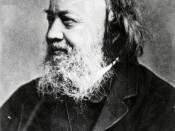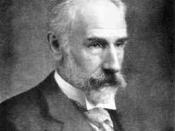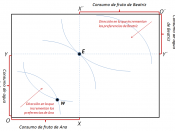The Victorian period of the British Isles was economically a tumultuous one. Within the span of 80 years the Isles went from a motley arrangement of farming communities and small factories to an industrial megaplex whose life's blood was the textile industry. Throughout this period, the agrarian classes went through a role reversal that took them from being agrarian laborers and piecework textile producers, whose textile exploits were for personal financial stability, or sometimes gain, to that of wage workers living under working conditions where their occupation was not simply a job but a form of slavery and a way of life. Finally, this chattel-like working population evolved into a stable working class where hours were long but not obscene and the quality of life could be measured by how many pleasurable exploits an individual took part in when not on the job. Throughout this time many schools of thought arose regarding the working class, and what was to be done with them.
Social thinkers such as Marx and Engles saw the working class as both the question and the answer to the social crisis they saw apparent in Europe; where one man would live in squalor while another lived in luxury. Others such as F.Y. Edgeworth generally dehumanized the plight of the masses and translated the social condition into a series of mathematical formulas where every human's net worth to society could be calculated by a series of figures. Still more economic thinkers such as Michael Sadler, Lord Ashley, and Edwin Chadwick can be called the face of the parliamentary effort to improve the living conditions of both the poor and wage working classes. The nature of their work (evident by the way Sadler's economic questions were posed with the honest intent of leading one to morally acceptable answers, and Chadwick's passionate inquiry into the horrors of factory life - the "extent and operation of these evils"), showed a truly compassionate interest in the poor classes at large. Through the works of these social and economic philosophers it is possible to gain a barometric reading on the economic climate throughout Britain in the industrial revolution and post industrial revolution era.
When examining the developing economic climate of Britain during the Victorian period, it would seem that the landscape itself was somehow transformed overnight from an agrarian society where most finished goods were hand crafted, to an economic superpower where mechanized industry was king. Britain, being in a superb social and economic situation after the 18th century, contained a perfect mix of the elements necessary to develop an industrial economy, as summarized by Shepard B. Clough and Charles W. Cole in their Economic History of Europe:"⦠(1) manufacture by power-driven machines, (2) division of labor to perform specialized tasks rather than the entire job, (3) factory organization of industry, (4) ownership of the means of production not by workers, but by capitalists who were interested in making a profit, and (5) mass production of goods in quantities greater than were demanded by the workers, the immediate local market, or a small national trade."Britain, unlike many of their continental neighbors during the early 19th century possessed these elements which would prove to interact admirably together in creating an economic stronghold where British goods could be produced in such mass quantities that they were able to dominate not only domestic but foreign markets. Even as early as 1733 the stage was being set for the textile industry to become supreme with Kay's invention of the fly shuttle loom, which greatly increased both the speed and simplicity of the weaving process. Following this invention, the British patent office experienced a flurry of patents for machinery employed by the textile industry. However, while the growth of the textile industry was rapid, the industrial revolution in itself was not an instant occurrence; rather, it was the result of over three centuries of careful planning that resulted in a short but severe period of growing pains. When parliament passed the General Enclosure Act of 1801, it struck the death blow to the piecework textile practices of the farmer and agricultural laborer. These old-world practices usually involved spinning thread from cotton or wool that would be sold to a middle man so that they could be sold again in mass quantities to factories, or in some cases, homespun cloths made on primitive looms for personal or family use. Nonetheless, when the agrarian laborers were forced out of their way of life due to the financial burdens that the Enclosure Acts forced upon them (life became unsustainable due to the fact that arable land was inaccessible by the average man due to the cost of fencing, or forced selling to a more wealthy individual due to land locked property), it became necessary to find work elsewhere. Therefore, the second need of an industrializing country could be met now that there was a population that could be converted into specialized workers. This conversion was not to be a painless one, and with change always comes resistance to it. In this case, resistance came in the form of agrarian workers going from a life where they could scrape by and in some cases make a little profit, to working week to week for their impossibly low wages - and not being able to keep out of debt due to the insufficiency of their earnings.
The economist Francis Y. Edgeworth was noted by Robert L. Heilbroner as a "strange" and "neurotically shy" man who "was as ill constructed a pleasure machine as can be imagined." Known for being a minimalist, Edgeworth avoided the common creature comforts that humans typically seek out, and in their place substituted his tireless work into the mathematical functioning of human behavior. Edgeworth felt that every action that humans carried out could fit a series of mathematical formulas that could explain why a man acted as he did. It followed that Edgeworth could in theory fit human life mathematically into the work of Jeremy Bentham and his concept of men arranging their lives into a series of profits and losses so that they could live their lives to the best of their financial reaches. Within Edgeworth's works are seemingly endless mathematical formulas that describe the input and output of a man within the natural world, and how after some calculation and consideration, one would be able to predict the trends within a society and economy. Nonetheless, the works produced by Edgeworth during and after the industrial revolution provided a clear, concise, and dehumanizing look into the world of the wage worker. Examples of this are found within works such as The Objects and Methods of Political Economy, where Edgeworth compares the workings of predicting the political economy to that of the formulas used in artillery: when one knows the laws governing an event, it becomes possible to accurately judge and accomplish a given goal, or in this case hitting one's mark. Other works like The Laws of Increasing and Diminishing Returns illustrate Edgeworth's interest and fascination into the pure mathematical results of how to maximize the profits and production of a given product with total ignorance to the amount of physical harm or toil required by the laborer. Through Edgeworth's works it is possible to see how the "fiscal controllers" could ignore the plight of the working man and concentrate on the sheer profit to be maximized by overworking and underpaying their workers, which shows why his works gained so much popularity in the upper classes.
During the occupational changeover of the working class, the individual had to make adjustments to their lifestyle in order to cope with the changing income and occupational availability. The niche formerly occupied by these individuals in the pre-industrial era was now gone and therefore it became necessary to modify their economic strategy in order to survive in the increasingly bleak life of underpayment and overwork. Unfortunately, to profit or financially advance under the new wage system became something of a pipe dream. When industrialization was taking shape in Britain, the largest need of the industries was human labor; the working capital and ingenuity already existed thanks to previous inventions and riches accrued under the old systems from previous eras. Thus, the new and old industrialists alike, seeing a new opportunity for profit, wasted no time in exploiting the growing proletariat class into a social bracket of debt slaves; the labors that they performed never amounted to any financial gain besides bare survival for the worker. Conversely, the situation provided in some cases never-ceasing profits for the factory owners and low-level aristocrats, or bourgeois. Conditions for the proletariat were those of dismal squalor and desperation, as emphasized heavily in the Sadler Committee Reports. Excellent examples of the human strife involved with the proletariat of this can be seen in the testimony of Joshua Drake, a member of the proletariat and father of apparently many children. When Drake was asked why he allows his children to work in such deplorable conditions in Victorian textile mills he responded with the cold reality that, "Necessity compels a man that has children to let them work." Also, when asked if he was receiving assistance from his church, he replies no, and when asked if he had the option of not letting his children work in the textile mills, he replies that he would not allow it. Though this is a mild testimony as compared with the emotional testimonies given before the Ashley Mine Commission, one must remember that many of Sadler's questions were leading. However, aside form the manner that the questions were asked, it is important to recall that the testimony here bore a direct view into the plight of the proletariat where not even the church was willing to help them out of their predicament.
While thinkers such as Edgewood and Bentham concerned themselves with the dehumanized and mathematical workings of the economy and society, others arose that were much more concerned with the condition and humanity of the working class. Referred to by Heilbroner as "creatures of the devil", the social and political theorists Karl Marx and Friedrich Engles were taking a much more in-depth look into the world of the working man. While the textile industry roared to life in the cities of Britain, there came with this evolution a noticeably dark change in not only the location and size of the lower, working class, but over time a change even in the physical form of the humans that worked in these mills. As evidenced by Hansard's Parliamentary Debates, the factory laborers themselves had deformed and deteriorated into mere remnants of human beings where, when called upon for a visual inspection "stood or squatted before me in all the shapes of the letters of the alphabet." Such examples of human cruelty provided evidence for the realization of the theories of thinkers such as Marx and Engles. They saw in the deplorable factory conditions of the time a window of opportunity where they could make a difference in the condition and status of not only the classes being crushed by capitalism, but also in the class causing the negative condition on the working classes as well. Aside from the early independent works of Marx and Engles, the particular intellectual labor that they are remember for, and usually deified or demonized for, is the Communist Manifesto. The Manifesto by design was Marx and Engles' handbook for an angry proletariat to follow in order to rise up and overthrow the ruling bourgeoisie. Primarily the work of Marx, it became an accumulation of his personal scholarly insight and views on the ways a capitalist government or social system that had become overbearing on a people not only should be but had to be overthrown by the people being ruled by it for it was going to die a slow death in the end. Within the Manifesto elements of Marx's early intellectual diet can be seen, with the social and political philosophies of Voltaire, Locke, and Diderot making appearances throughout.
Throughout all of the turmoil the British proletariat was facing from its inception with the passing of the enclosure laws to its rapid and painful growth during the industrial revolution, there was some form of a light at the end of the tunnel for the individual. As to not be completely abandoned by their government, Parliament began sever inquests into the realm of British industry due to the rising increase of a population in turmoil. The founder of this "crusade" into child and unfair labor was Michael Sadler. Sadler from his youth was of the compassionate sort, as his entire family were Methodist sympathizers though they themselves were Anglicans. Sadler first found work with the poor in Ireland as treasurer of the poor laws. Sadler found himself in a parliamentary position for the first time in 1829 when he won the election for the Newark seat, and in 1830 after relocating began his inter parliamentary work on the conditions and treatment of the poor. Unsuccessful at first, Sadler moved to bring forth actual proletariat workers in front of parliament in order to sway parliamentary votes in favor of his resolutions. However, Sadler was not as successful as he had hoped to be, and in 1832 he was defeated by John Marshall, a flax industry magnate who used his influence to sway votes. However, when the Sadler commission reports were passed, the British public at large began a grassroots push to have the poor laws reformed, and the factory workers reform movement was taken over by Lord Ashley after Sadler's departure. Ashley largely continued Sadler's work and after several inquests into the condition of the British labor force, the most famous being the Ashley Commission on the Mines. In 1833, Lord Ashley saw the fruit of his and his predecessors work be gloriously defeated in front of parliament. Ashley's bill included many labor reforms which would have come as a godsend to the proletariat including the abolition of the employ of children under the age of 9, and the limit of 8 hour work days to children ages 9-13. However, the bill did not pass for the parliament felt that the bill did not go far enough in order to protect children. In 1840 Lord Ashley assisted in the formation of the Children's Employment Commission which produced its first report in 1842, causing a sensationalist reaction within the population at large which resulted in a parliamentary reaction to begin regulation of labor and the treatment of the proletariat.
Though the path of the Victorian Era proletariat was not an easy one, they received help and hindrance from many sources, ultimately ending in the advancement of a large part of the population. While some thinkers were attempting to dehumanize the plight of the population, many were trying multiple avenues in order to advance it. Though individuals such as Edgeworth did not see a human problem and a human solution, others worked their entire lives to further the cause of the proletariat and empower them to such a state that they would actually benefit from the industrialization that had so long hindered their progress as a class of people. While neither extreme took hold in Britain, the economic debate that ensued throughout the Victorian period helped to bring questions of class and the means of production into the open, and allowed for further discussion of the topic to continue, even to today as radicals on both sides still attempt to further the ideals pioneered by the great economic thinkers of the 19th century. Perhaps the best that can be said of the period is that it allowed for a wider range of beliefs and ideals to pervade the British society, such that economic questions were no longer a simple matter of taxes and class struggles; the struggles of the 19th century were felt by all in British society, not simply by the thinkers and the workers. The economic and social questions that arose out the period were further queried by thinkers with no economic background at all, as poets and thinkers such as Elizabeth Barret Browning and Matthew Arnold joined in the great debate. Thus, the example was set by Britain that economics truly were concerned with all the people in society, the great and the small.
BibliographyClough, Shepard B., and Charles W. Cole. Economic History of Europe. Boston: D. C. Health and Company, 1941.
Edgeworth, Francis Y. Papers Relating to Political Economy. New York: Burt Franklin, 1925.
Heilbroner, Robert L. The Wordly Philosophers. New York: Touchstone, 1999.
Rapport, Michael. Ninteenth Century Europe. New York: Palgrave Macmillan, 2005.
Scott, Jonathan F., and Alexander Baltzly. Readings in European History Since 1814. New York: F.S. Crofts & Co., 1934.





